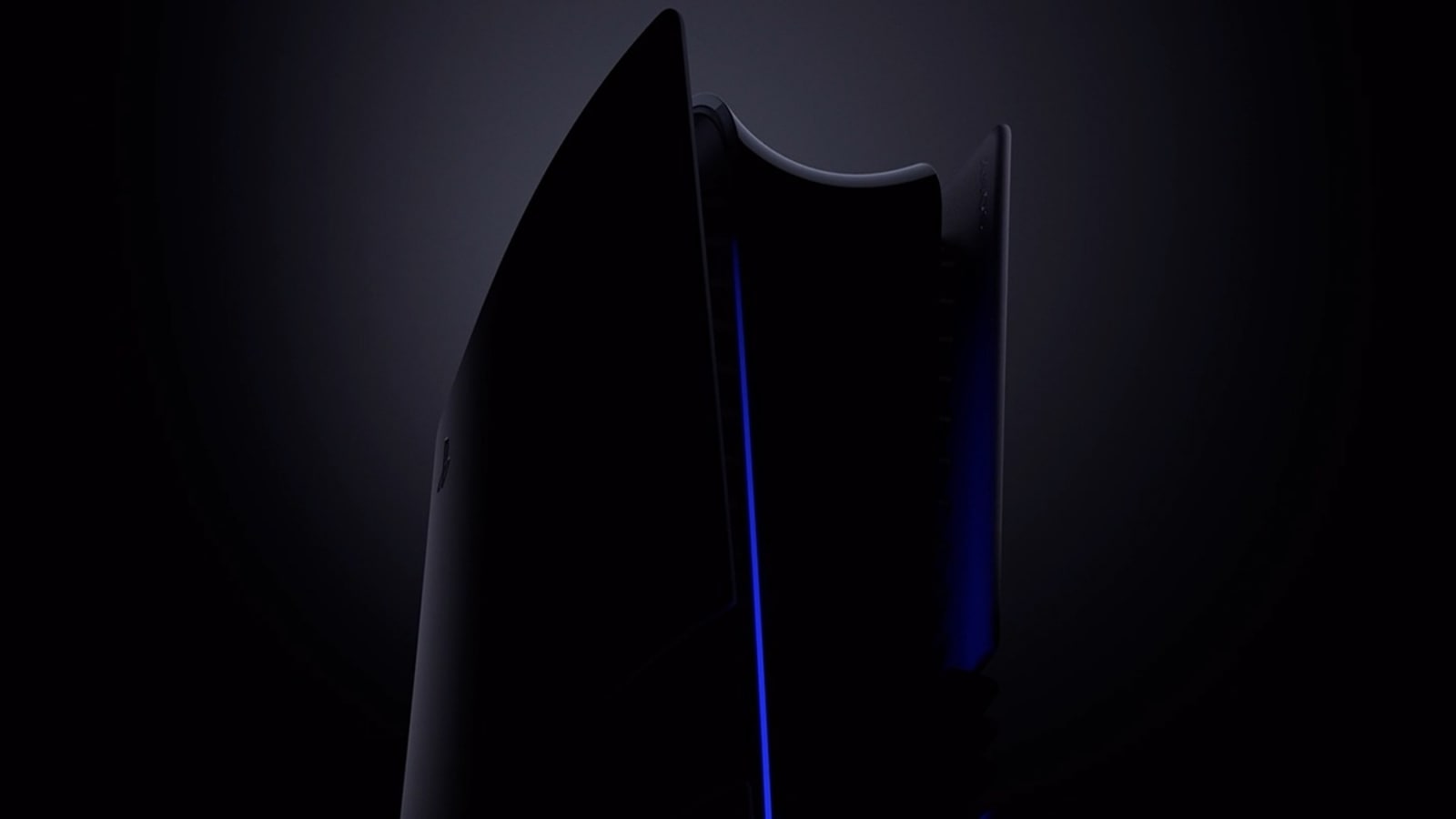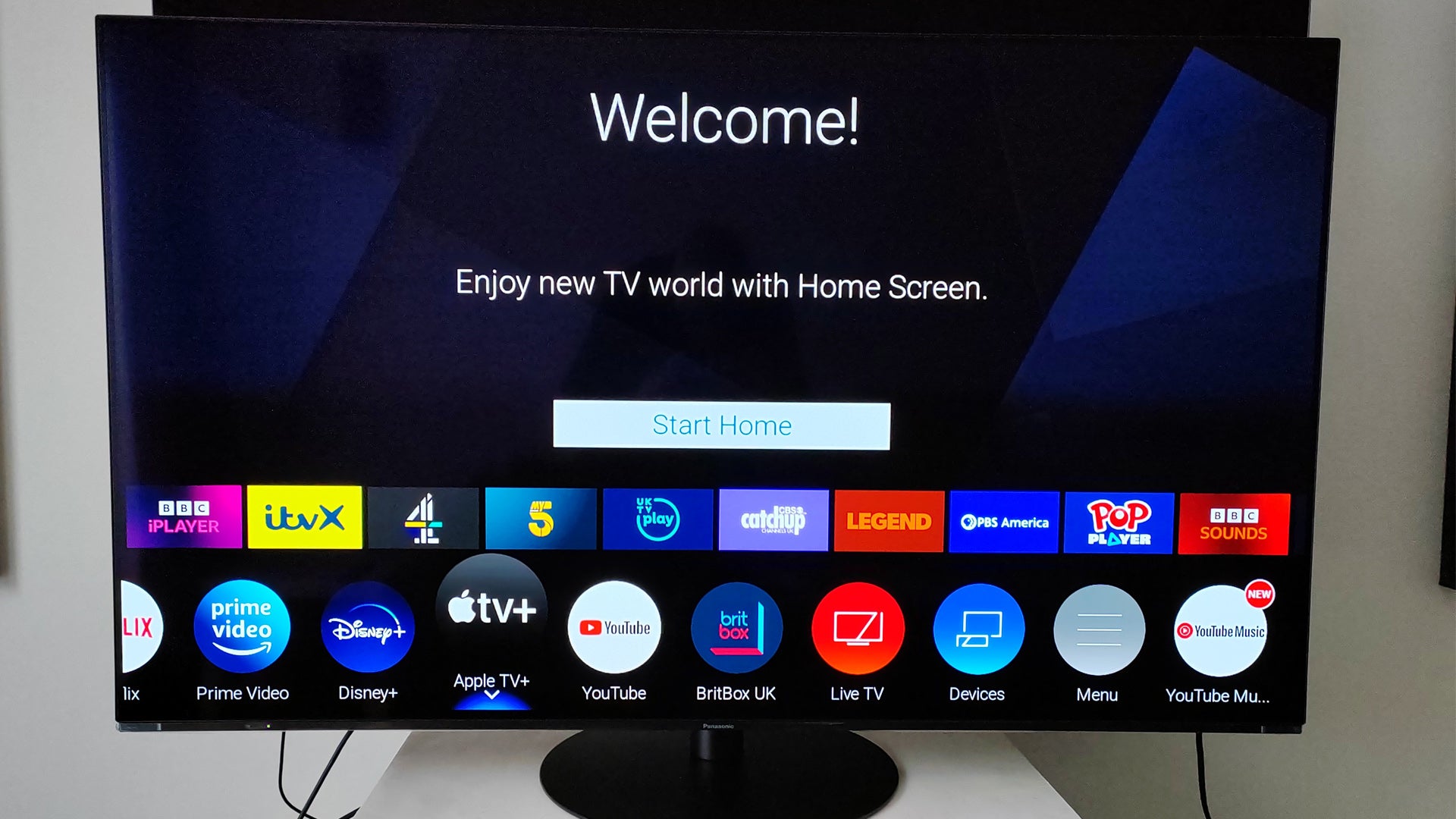Verdict
The LZ1000 is arguably the biggest surprise in Panasonic’s current OLED line up. It may sit below the brand’s hero models, but picture quality and usability – which includes a dedicated gaming UI – are right up there. This is a great screen for home cinema fans, thanks to cinematic movie modes that blend excellent colour fidelity with punchy contrast. Don’t expect too much from its audio though…
Pros
- Refined picture quality
- Game Mode Extreme Control Board
- Dolby Vision and HDR10+ Adaptive support
Cons
- Average audio performance
- Only two HDMI inputs are 4K/120Hz capable
Availability
- UKRRP: £1099
- USAunavailable
- EuropeTBC
- Canadaunavailable
- Australiaunavailable
Introduction
The LZ1000 is the most affordable of Panasonic’s OLED EX-based premium screens. Representing a considerable saving on the brand’s flagship LZ2000, not least because it lacks that model’s extravagant Dolby Atmos sound system, it’s an intriguing alternative to the LG C2 and Samsung S95B.
Panasonic designates the LZ1000’s panel as ‘Master OLED’. While it uses the same glass as its more expensive stablemates, it doesn’t benefit from their hardware heatsink, so it can’t quite hit the same levels of peak brightness, hence those models are dubbed Master OLED Pro models.
But does that really impact everyday viewing? Read on to learn why I think this OLED TV is something of a steal.
The Panasonic LZ1000 is available now in two screen sizes, 55- and 65-inches (TX-55LZ1000B, TX-65LZ1000B), priced at £1099 and £1499 respectively. It’s exclusive to John Lewis stores in the UK. The LZ1000 range is not available in North America or Australia.
The 55-inch model is being reviewed here.
When it comes to hierarchy, the LZ1000 is positioned below the Panasonic LZ1500, but above the LZ980 (both of which are available in 65-, 55-, 48-, and 42-inch screens sizes).
Design
- Classic, thin-bezel styling
- Swivel stand
- Premium remote control
There’s nothing outlandish about this model’s design. It’s classically stylish, just 69mm deep, and should suit any décor. The central stand, which is easy to accommodate on AV furniture, swivels. I actually used this feature far more useful than I thought I would. It’s perfect for solo viewing when you have a comfy chair that’s just off axis.
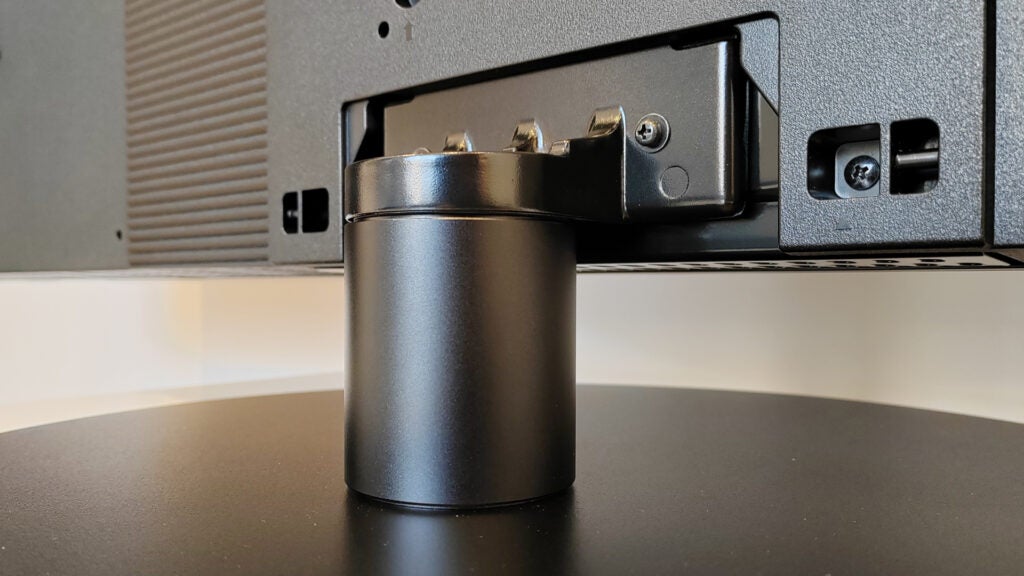
The remote control has a very nice brushed metal finish, and feels substantial in the hand. There are dedicated shortcut buttons for Netflix, Prime Video, Rakuten TV, YouTube, Disney+ and Freeview Play.
While the set is 4K/120Hz capable, giving ultra-smooth High Frame Rate gameplay, only two of its four HDMIs are v2.1 capable (1 and 2). There’s eARC on input 2. On the plus side, all four have ALLM (auto low latency mode) game mode support.
Other connections include a digital optical audio output, three USB ports and Ethernet, to complement Bluetooth and Wi-Fi. For those that require it, there’s also a CI card slot.
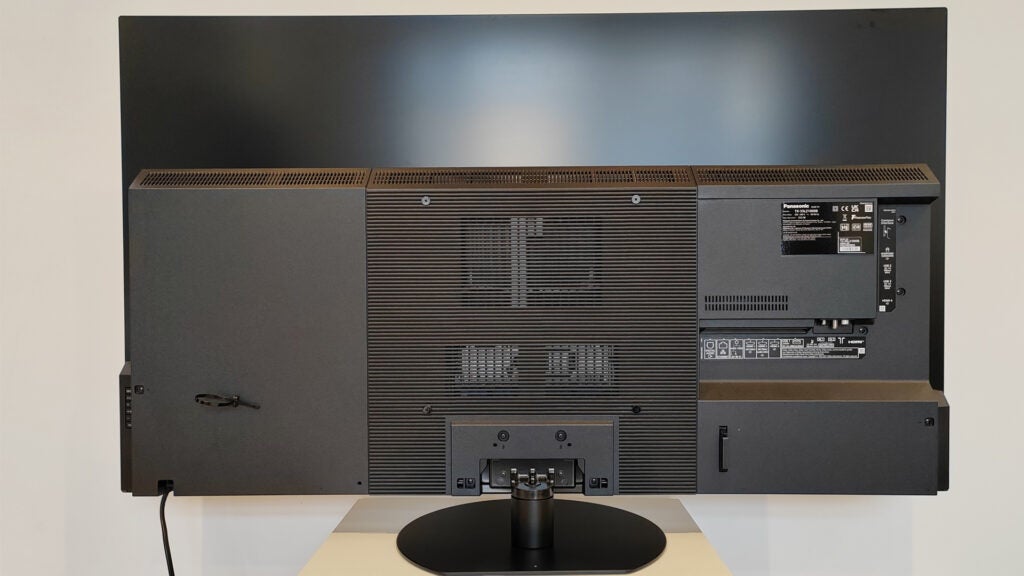
Features
- Customisable My Home Screen v7
- Game Mode Extreme Control Board
- Works with Google Assistant and Amazon Alexa
Panasonic straddles two camps when it comes to smart TV support. Mainstream models tend to feature Android, while premium models get its proprietary My Home Screen, which is what we have here in its latest v7.0 guise.
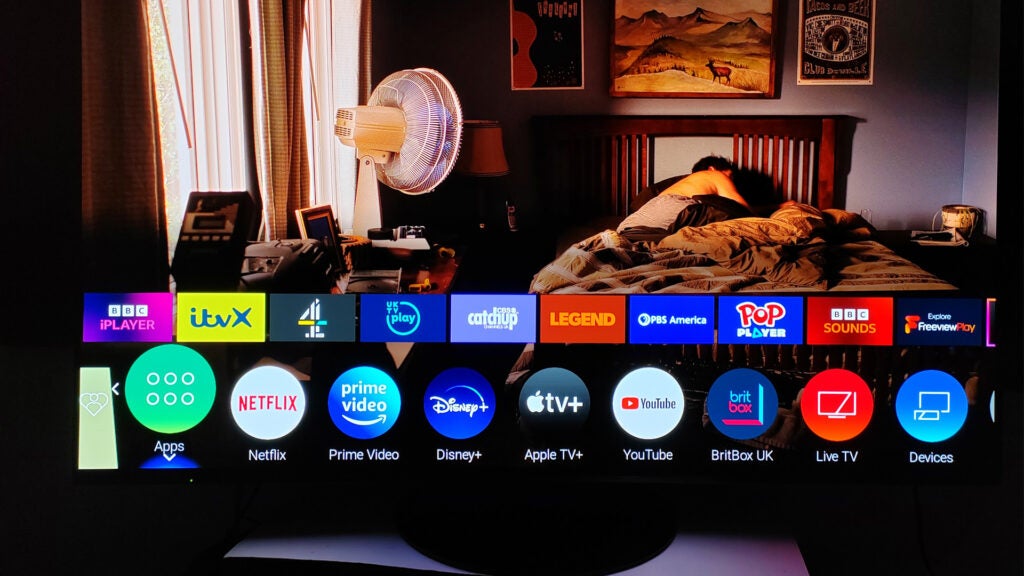
I’ve always rather liked My Home Screen, because it’s easy to customise and generally unobtrusive. While its three main rivals (Samsung’s Tizen, LG’s webOS and Android) hog the whole screen, this platform is content with a launch bar that runs across the bottom of the screen. Push the Home button, and a customisable selection of buttons appear. It’s dead easy to use.
Voice control is available via Google Assistant and Amazon Alexa.
What’s new to the mix is a Game Mode Extreme Control Board. This dedicated UI gathers relevant gaming info in one place. There’s Dark Visibility adjustment, to help you see better in the shadows, plus frame rate, VRR, and resolution details.
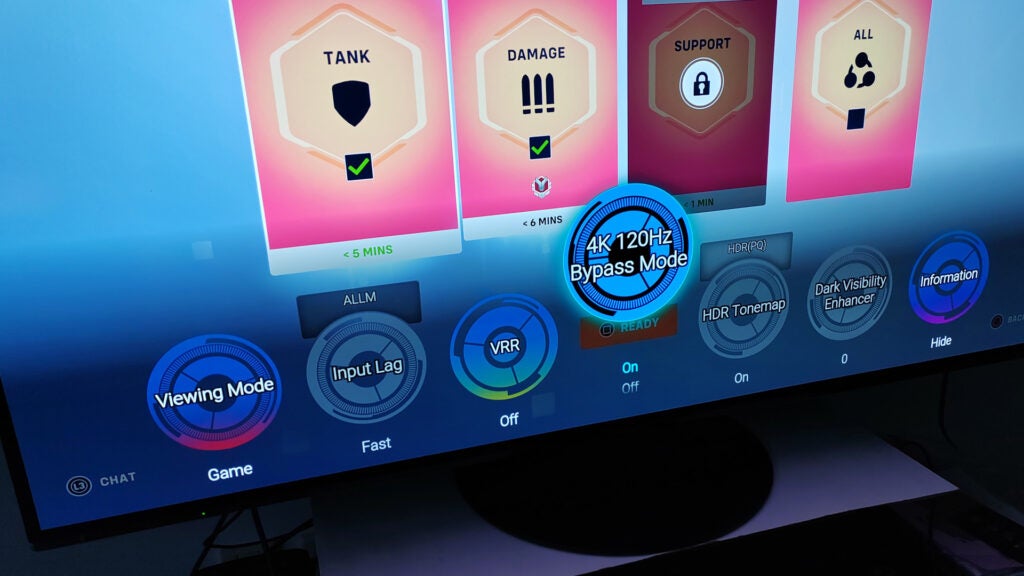
Make sure you enable 4K pass-through, to ensure full 4K resolution from a connected games console. The LZ1000 supports AMD FreeSync Premium, but there’s no HGiG gaming HDR mode.
Latency is good but not outstanding. I measured input lag at 14.5ms (1080/60), when in Game mode.
Picture Quality
- Dolby Vision IQ
- HCX Pro AI Processor
The LZ1000 may not have the heat dissipating tech of its numerical superiors, but there’s actually not a whole lot separating them come popcorn time. The LZ1000 delivers a consistent, balanced picture.
Near shadow detail is very good (and obviously letterbox bars all but disappear in a dark viewing room). As John Krasinski and Emily Blunt scavenge a pharmacy at the start of A Quiet Place, the screen presents just enough detail on the shadowed shelves yet retains the brightness of the light flooding down the aisle.
Skin tones and texture reproduction is excellent. The set employs Panasonic’s latest HCX Pro AI chipset, which can analyse content frame by frame in real time, via an on-board database, to ensure the most accurate representation. Big close ups exhibit astonishing detail.
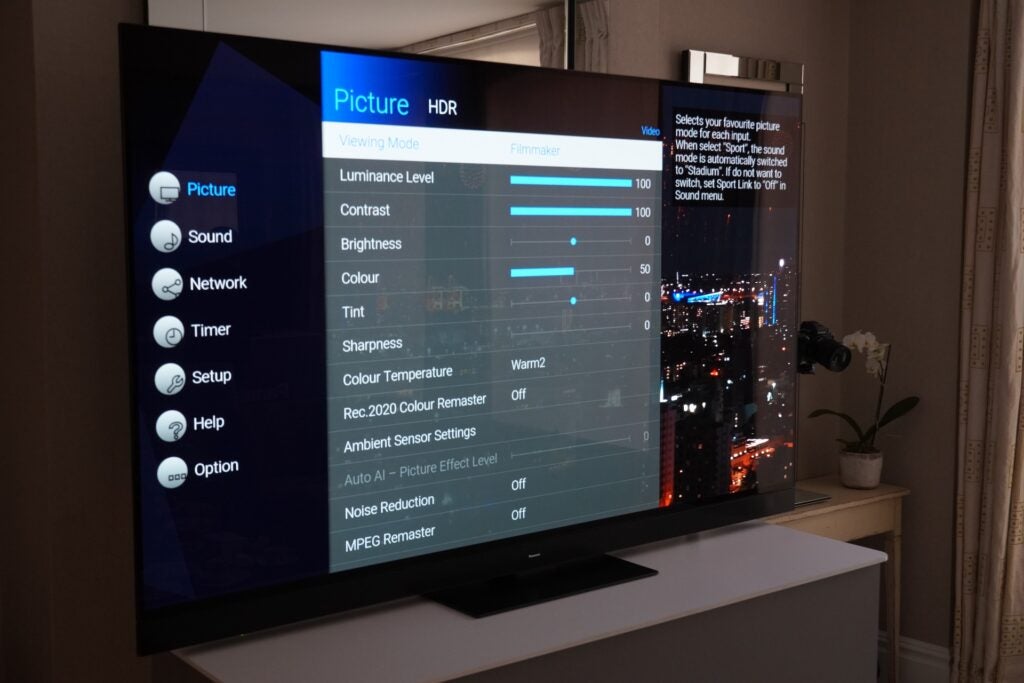
Even sans heatsink, the set’s HDR performance is actually very good. I measured HDR peak brightness, in a 5 per cent window, at just under 900 nits (897.6 nits to be precise), using the Normal viewing mode. Measured with a 10 per cent patch, which is actually less indicative of the bright specular highlights you might see in a movie, the set turned in a respectable 747 nits.
Universal HDR support, long common to Panasonic tellies, is taken to the next level with Dolby Vision IQ and HDR10+ Adaptive, which use the set’s sensor to dynamically adjust and optimise the picture relative to ambient light. This is an extension of Intelligent Sensing that has been used by Panasonic in its Filmmaker mode. It’s generally a good thing.
I was occasionally aware of some posterization effects, particularly during the first episode of The Last of Us, but tonal gradations appear smooth.
Colour fidelity gets top marks – the LZ1000 boasts final colour tuning by Hollywood colourist Stefan Sonnenfeld. Vibrant when required, but it’s never over-wrought (if you don’t count Dynamic mode).
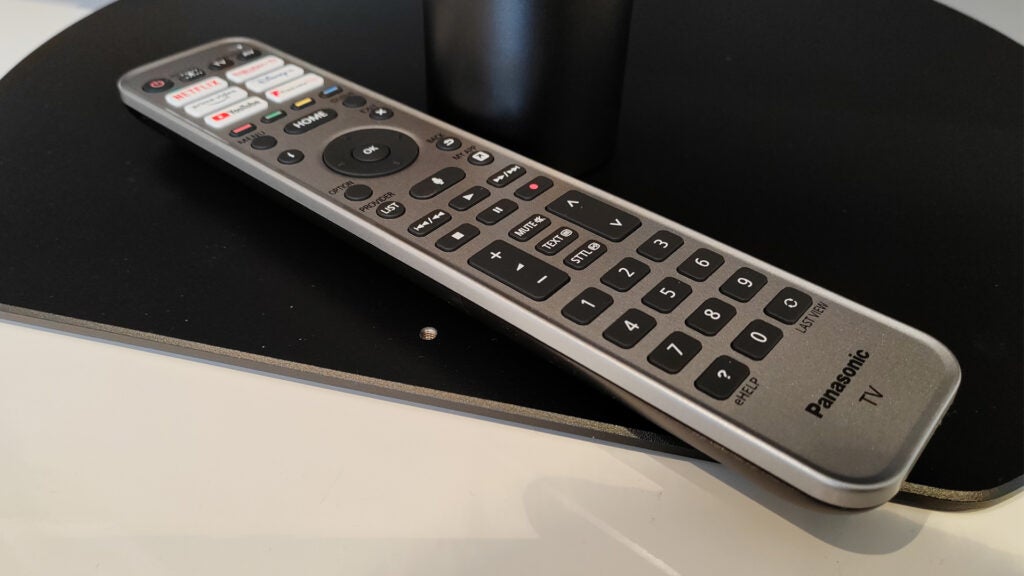
Panasonic offers a wide variety of picture presets. The latest addition to the roster is Auto AI, which for many viewers will probably be the go-to setting. It handles a wide variety of content well, but typically runs with motion smoothing set to Max, which I find a bit distracting on anything other than sports or studio footage.
Alternate image presets include Normal, Cinema, Filmmaker mode, True Cinema, Custom, Professional, and Sport. My preferred option/recommendation is either Normal or Cinema, with Intelligent Frame Creation set to Minimum, at best.
The set’s gaming performance is terrific. A PlayStation 5, outputting at 4K/120fps, combines superb detail with buttery smoothness. It’s a joy to play on. What a shame all four HDMIs aren’t v2.1 enabled!
Sound Quality
Inevitably, the set’s audio performance is less noteworthy, but that’s by design. The LZ1000 has a stereo speaker system, rated at 30W total.
It’ll do the job, but you’ll surely want to add a soundbar or full home cinema system to enhance theatrics. Dolby Atmos will bitstream out from the screen over eARC.
Latest deals
Should you buy it?
You’re a movie fan looking to upgrade your telly: The LZ1000 is a fantastic display for film fanatics. Its colour performance and nuanced contrast is exceptional at this price point. Partner it with a 4K UHD Blu-ray player, 4K TV set top box or media streamer and every night will look like a West End premiere…
You want the brightest HDR performance possible: Both the Panasonic LZ1500 and LZ2000 can out sparkle the LZ1000, by dint of their ability to drive OLED panel technology harder. That means they offer brighter specular highlights (headlights, torch effects, that kind of thing).
Final Thoughts
The LZ1000 can be considered an excellent value. It offers much that we love about Panasonic OLED, beautifully balanced, cinematic images and accurate colour, at a head-turning price.
The icing on the cake is the addition of the Game Board Extreme interface with 4K/120fps support. High Frame Rate gameplay is incredibly responsive, and the visuals are beautiful.
Couple all this to a superior smart TV experience and stylish good looks, and you’ve got a winner. Just remember to budget for a soundbar.
How we test
We test every television we review thoroughly over an extended period of time. We use industry standard tests to compare features properly. We’ll always tell you what we find. We never, ever, accept money to review a product.
Find out more about how we test in our ethics policy.
FAQs
The LZ1000 OLED does have an OLED EX panel from LG that allows it to reach higher brightness with HDR content. However, this isn’t the quite same as the Master OLED Pro Panasonic uses for its more expensive OLEDs, which is a combination of the OLED EX screen and customisations made by Panasonic to reach over 1000 nits of brightness.
Sustainability
Trusted Reviews’ holds the fact that global warming is not a myth as a core value and will continuously endeavour to help protect our planet from harm in its business practices.
As part of this mission, whenever we review a product we send the company a series of questions to help us gauge and make transparent the impact the device has on the environment.
We currently haven’t received answers to the questions on this product, but will update this page the moment we do. You can see a detailed breakdown of the questions we ask and why in our sustainability
Jargon buster
OLED EX
OLED EX is a panel technology created by LG Display that uses a different material (deuterium) than older panels to help increase brightness
Dolby Atmos
Dolby Atmos is an object-based audio format. It expands on 5.1 and 7.1 soundtracks by adding overhead channels. Sounds are referred to as “audio objects”, of which there can be up to 128 audio channels, and these ‘objects’ can be accurately positioned within a 3D soundscape. This allows soundtracks that support the technology to place sounds above and around the listener with compatible kit.
Verdict
The LZ1000 is arguably the biggest surprise in Panasonic’s current OLED line up. It may sit below the brand’s hero models, but picture quality and usability – which includes a dedicated gaming UI – are right up there. This is a great screen for home cinema fans, thanks to cinematic movie modes that blend excellent colour fidelity with punchy contrast. Don’t expect too much from its audio though…
Pros
- Refined picture quality
- Game Mode Extreme Control Board
- Dolby Vision and HDR10+ Adaptive support
Cons
- Average audio performance
- Only two HDMI inputs are 4K/120Hz capable
Availability
- UKRRP: £1099
- USAunavailable
- EuropeTBC
- Canadaunavailable
- Australiaunavailable
Introduction
The LZ1000 is the most affordable of Panasonic’s OLED EX-based premium screens. Representing a considerable saving on the brand’s flagship LZ2000, not least because it lacks that model’s extravagant Dolby Atmos sound system, it’s an intriguing alternative to the LG C2 and Samsung S95B.
Panasonic designates the LZ1000’s panel as ‘Master OLED’. While it uses the same glass as its more expensive stablemates, it doesn’t benefit from their hardware heatsink, so it can’t quite hit the same levels of peak brightness, hence those models are dubbed Master OLED Pro models.
But does that really impact everyday viewing? Read on to learn why I think this OLED TV is something of a steal.
The Panasonic LZ1000 is available now in two screen sizes, 55- and 65-inches (TX-55LZ1000B, TX-65LZ1000B), priced at £1099 and £1499 respectively. It’s exclusive to John Lewis stores in the UK. The LZ1000 range is not available in North America or Australia.
The 55-inch model is being reviewed here.
When it comes to hierarchy, the LZ1000 is positioned below the Panasonic LZ1500, but above the LZ980 (both of which are available in 65-, 55-, 48-, and 42-inch screens sizes).
Design
- Classic, thin-bezel styling
- Swivel stand
- Premium remote control
There’s nothing outlandish about this model’s design. It’s classically stylish, just 69mm deep, and should suit any décor. The central stand, which is easy to accommodate on AV furniture, swivels. I actually used this feature far more useful than I thought I would. It’s perfect for solo viewing when you have a comfy chair that’s just off axis.

The remote control has a very nice brushed metal finish, and feels substantial in the hand. There are dedicated shortcut buttons for Netflix, Prime Video, Rakuten TV, YouTube, Disney+ and Freeview Play.
While the set is 4K/120Hz capable, giving ultra-smooth High Frame Rate gameplay, only two of its four HDMIs are v2.1 capable (1 and 2). There’s eARC on input 2. On the plus side, all four have ALLM (auto low latency mode) game mode support.
Other connections include a digital optical audio output, three USB ports and Ethernet, to complement Bluetooth and Wi-Fi. For those that require it, there’s also a CI card slot.

Features
- Customisable My Home Screen v7
- Game Mode Extreme Control Board
- Works with Google Assistant and Amazon Alexa
Panasonic straddles two camps when it comes to smart TV support. Mainstream models tend to feature Android, while premium models get its proprietary My Home Screen, which is what we have here in its latest v7.0 guise.

I’ve always rather liked My Home Screen, because it’s easy to customise and generally unobtrusive. While its three main rivals (Samsung’s Tizen, LG’s webOS and Android) hog the whole screen, this platform is content with a launch bar that runs across the bottom of the screen. Push the Home button, and a customisable selection of buttons appear. It’s dead easy to use.
Voice control is available via Google Assistant and Amazon Alexa.
What’s new to the mix is a Game Mode Extreme Control Board. This dedicated UI gathers relevant gaming info in one place. There’s Dark Visibility adjustment, to help you see better in the shadows, plus frame rate, VRR, and resolution details.

Make sure you enable 4K pass-through, to ensure full 4K resolution from a connected games console. The LZ1000 supports AMD FreeSync Premium, but there’s no HGiG gaming HDR mode.
Latency is good but not outstanding. I measured input lag at 14.5ms (1080/60), when in Game mode.
Picture Quality
- Dolby Vision IQ
- HCX Pro AI Processor
The LZ1000 may not have the heat dissipating tech of its numerical superiors, but there’s actually not a whole lot separating them come popcorn time. The LZ1000 delivers a consistent, balanced picture.
Near shadow detail is very good (and obviously letterbox bars all but disappear in a dark viewing room). As John Krasinski and Emily Blunt scavenge a pharmacy at the start of A Quiet Place, the screen presents just enough detail on the shadowed shelves yet retains the brightness of the light flooding down the aisle.
Skin tones and texture reproduction is excellent. The set employs Panasonic’s latest HCX Pro AI chipset, which can analyse content frame by frame in real time, via an on-board database, to ensure the most accurate representation. Big close ups exhibit astonishing detail.

Even sans heatsink, the set’s HDR performance is actually very good. I measured HDR peak brightness, in a 5 per cent window, at just under 900 nits (897.6 nits to be precise), using the Normal viewing mode. Measured with a 10 per cent patch, which is actually less indicative of the bright specular highlights you might see in a movie, the set turned in a respectable 747 nits.
Universal HDR support, long common to Panasonic tellies, is taken to the next level with Dolby Vision IQ and HDR10+ Adaptive, which use the set’s sensor to dynamically adjust and optimise the picture relative to ambient light. This is an extension of Intelligent Sensing that has been used by Panasonic in its Filmmaker mode. It’s generally a good thing.
I was occasionally aware of some posterization effects, particularly during the first episode of The Last of Us, but tonal gradations appear smooth.
Colour fidelity gets top marks – the LZ1000 boasts final colour tuning by Hollywood colourist Stefan Sonnenfeld. Vibrant when required, but it’s never over-wrought (if you don’t count Dynamic mode).

Panasonic offers a wide variety of picture presets. The latest addition to the roster is Auto AI, which for many viewers will probably be the go-to setting. It handles a wide variety of content well, but typically runs with motion smoothing set to Max, which I find a bit distracting on anything other than sports or studio footage.
Alternate image presets include Normal, Cinema, Filmmaker mode, True Cinema, Custom, Professional, and Sport. My preferred option/recommendation is either Normal or Cinema, with Intelligent Frame Creation set to Minimum, at best.
The set’s gaming performance is terrific. A PlayStation 5, outputting at 4K/120fps, combines superb detail with buttery smoothness. It’s a joy to play on. What a shame all four HDMIs aren’t v2.1 enabled!
Sound Quality
Inevitably, the set’s audio performance is less noteworthy, but that’s by design. The LZ1000 has a stereo speaker system, rated at 30W total.
It’ll do the job, but you’ll surely want to add a soundbar or full home cinema system to enhance theatrics. Dolby Atmos will bitstream out from the screen over eARC.
Latest deals
Should you buy it?
You’re a movie fan looking to upgrade your telly: The LZ1000 is a fantastic display for film fanatics. Its colour performance and nuanced contrast is exceptional at this price point. Partner it with a 4K UHD Blu-ray player, 4K TV set top box or media streamer and every night will look like a West End premiere…
You want the brightest HDR performance possible: Both the Panasonic LZ1500 and LZ2000 can out sparkle the LZ1000, by dint of their ability to drive OLED panel technology harder. That means they offer brighter specular highlights (headlights, torch effects, that kind of thing).
Final Thoughts
The LZ1000 can be considered an excellent value. It offers much that we love about Panasonic OLED, beautifully balanced, cinematic images and accurate colour, at a head-turning price.
The icing on the cake is the addition of the Game Board Extreme interface with 4K/120fps support. High Frame Rate gameplay is incredibly responsive, and the visuals are beautiful.
Couple all this to a superior smart TV experience and stylish good looks, and you’ve got a winner. Just remember to budget for a soundbar.
How we test
We test every television we review thoroughly over an extended period of time. We use industry standard tests to compare features properly. We’ll always tell you what we find. We never, ever, accept money to review a product.
Find out more about how we test in our ethics policy.
FAQs
The LZ1000 OLED does have an OLED EX panel from LG that allows it to reach higher brightness with HDR content. However, this isn’t the quite same as the Master OLED Pro Panasonic uses for its more expensive OLEDs, which is a combination of the OLED EX screen and customisations made by Panasonic to reach over 1000 nits of brightness.
Sustainability
Trusted Reviews’ holds the fact that global warming is not a myth as a core value and will continuously endeavour to help protect our planet from harm in its business practices.
As part of this mission, whenever we review a product we send the company a series of questions to help us gauge and make transparent the impact the device has on the environment.
We currently haven’t received answers to the questions on this product, but will update this page the moment we do. You can see a detailed breakdown of the questions we ask and why in our sustainability
Jargon buster
OLED EX
OLED EX is a panel technology created by LG Display that uses a different material (deuterium) than older panels to help increase brightness
Dolby Atmos
Dolby Atmos is an object-based audio format. It expands on 5.1 and 7.1 soundtracks by adding overhead channels. Sounds are referred to as “audio objects”, of which there can be up to 128 audio channels, and these ‘objects’ can be accurately positioned within a 3D soundscape. This allows soundtracks that support the technology to place sounds above and around the listener with compatible kit.








